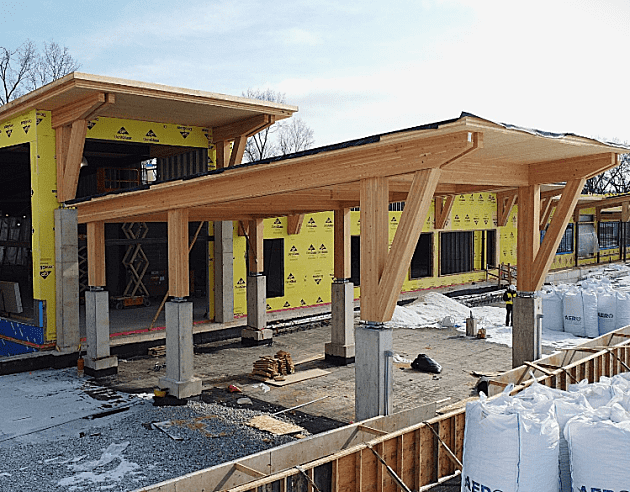- Project uploaded by Canadian Wood Council on 03-30-2023
- Project last updated by Canadian Wood Council on 06-10-2024
Phillip J. Currie Dinosaur Museum
Wembley, ABPhilip J. Currie Dinosaur Museum is an international institute for experiential learning dedicated to Alberta’s paleontological heritage through research, collection, preservation, exhibition, public programming, publications, and innovative outreach. Located within minutes from one of the world’s densest Mesozoic bone bed sites in Wembley, AB, it opened on September 3, 2015.
The design draws on an abstraction of the paleontological excavation experience, with two massive retaining walls of poured concrete and gabions pushing back the earth to reveal the main gallery wall. The museum includes classrooms, a paleo lab, Canada’s only theatre partnered with National Geographic, a restaurant, and a gift shop.
Wood was introduced as a natural element vital to the paleo heritage metaphor, akin to the skeletal finds of the excavated bone bed. Unique multifaceted zinc roof plates emulate the shifting tectonics of Earth over millions of years. This creates an exceptionally energy-efficient and sustainable building envelope able to handle the temperature extremes in the region. The entire building is heated and cooled by a displacement ventilation system located under the concrete floor of the museum.
The museum is supported by exposed beetle pine timber beams and struts, with complex asymmetrical wood nodes – the intersecting connection points of these members – that create a very structurally sound building. The nodes are a groundbreaking venture into the engineering of timber connections, with unique structural behaviour.
Using heavy timber for the supporting members would be fairly straightforward, but, due to the complex geometry and varying angles, difficulties were had with the structural nodes. Engineers explored ways of seamlessly holding the structure together to support the architectural intent. By working iteratively with the architect, a wood node was shaped in a way that respected the desired form and kept the size within element constraints. By testing the system with and without screw reinforcement, stress parameters could be deduced which could inform the structural analysis of the nodes themselves. Screws up to 19 mm in diameter and 1,200 mm long were used in a “strut-and-tie” fashion, much like rebar in concrete. Grasshopper, an algorithmic modeling plugin for Rhino, drove this process, making for a true digital fabrication design paradigm. The biggest nodes needed to be more than 1,500 mm tall by 2,400 mm wide, made with roughly 180 CNC pieces. The 3D automation allowed for small aligned drill holes on every layer, allowing for the installation of 150-mm long wood dowels so that the layers could be stacked on top of each other with precision. Temporary steel posts held the nodes in the z-direction while x and y were adjusted with cable-stays.
Project Details
-
Year Built
2015
-
Number Of Stories
1
-
Bldg system
Mass Timber
-
Sq. Meters
2,712
-
Construction Type:
Unknown
-
Building Type:
Civic (Recreational)
-
Material Types:
Mass Timber
Glue-Laminated Timber (GLT or glulam)
Lumber
Project Team
-
Fast + Epp Structural Engineer
-
StructureCraft Design-Build Subcontractor - Superstructure
-
Western Archrib Glulam
-
Gerald Epp Structural Engineer
-
PCL Construction Construction Management
-
Phillip J. Currie Dinosaur Museum Owner
-
Stantec Consulting Ltd. Architect of Record
-
Teeple Architects Architects
- Project uploaded by Canadian Wood Council on 03-30-2023
- Project last updated by Canadian Wood Council on 06-10-2024



 WOODWORKS
INNOVATION
NETWORK
WOODWORKS
INNOVATION
NETWORK







